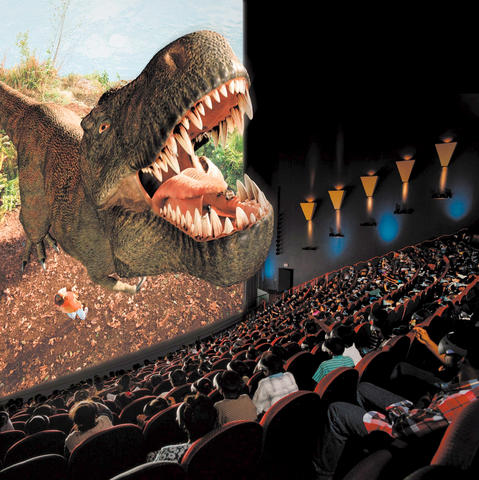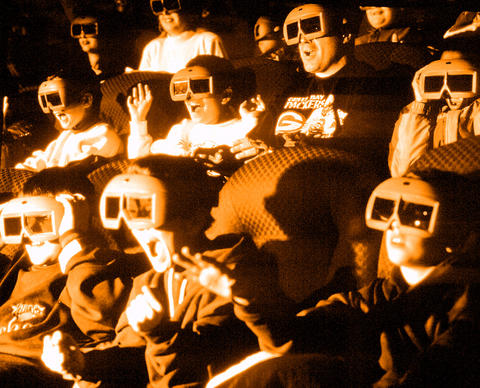I'm sitting in Paris and some butterflies are fluttering towards me. Loads of them, perfectly clearly. I could allow one to land on my hand, or catch one of the rose petals being blown towards me - except I can't, because they're not real. They're images on a TV in high definition - and in perfect 3D. They look life-sized and real, and I'm not wearing any silly spectacles other than the ones I wear all the time.
People have been working on convincing 3D without the glasses for a long time and the demo is breathtaking. It's on a prototype Philips TV, which won't be available for a while; it would cost US$20,500 at the moment, but that's expected to be vastly lower when it reaches the mass market. Philips isn't the only company investigating the possibilities; Luxembourg-based SeeReal has also made technological developments in the area with its Viewing Window Technology, aiming to reduce the amount of pixels you need before 3D works.
Orange has emerged as an unexpected early player in the market, and I'm watching the demo in its offices. It believes 3D TV will be key to the services it will be able to deliver to people's homes once its 100Mbps fiber-optic Internet service on trial in Paris takes off; hence its interest. The display moves to a beer advert that looks as though you could lift it off the screen, and then there's a demo of a computer game in genuine 3D with bullets flying at you. Four professionally cynical journalists are silenced for once. Later Orange takes a 3D photo of us and shows it to us on a handheld camera, with the hint that phones will do this, one day.

The technology works by throwing a different image to each eye and angling them so that one eye picks up one and the other picks up the other. There are in fact eight separate images, the technologists having added more after early users reported feelings of nausea and dizziness. "All of us have heard of 3D for games, for example, but it's not really 3D," says Philippe Delbary, head of 3D services for Orange. "It's just an attempt to represent depth."
The new technology shows actual 3D and it's impressive. It's not totally natural; if the camera has focused on the foreground, it's not possible to focus on the background as there is no clear image there for your eye to pick up. Once you're used to that it looks perfect. But how quickly will the market embrace it?
One key inhibitor Orange acknowledges is the availability of 3D material. Just two 3D-only films are in production - one by James Cameron and the other by Steven Spielberg - for release in 2009. And two movies, no matter how big, don't amount to a hill of beans when you're trying to establish a new standard.

Laurence Meyer, European Digital Home Analyst for Jupiter Research, regards this as a major drawback. "It will be a long process to have enough content," she says. Orange maintains that within 10 years we will all be watching 3D and demanding existing shows and films be upgraded to look the same. "When people have discovered 3D, they will no longer watch 2D," Delbary says.
But historically, things haven't moved so quickly. Jupiter's Meyer points out that high-definition TV is taking off at the moment, although sluggishly, and there is confusion in the market as to what sort of TV you need to buy: "HD was first demonstrated almost 20 years ago; that's how long it takes," she says. There is a lot for customers to understand about television at the moment, what with high definition, digital switchover and IP (Internet) TV all jostling for our attention. "Digital TV is more transparent to the viewer," she says. "They tend to buy a package rather than a technology. But [the example of] HD suggests take-up [of 3D] will be slower than 10 years."
Another precedent is the move a couple of decades ago to "colorize" everything. The vested interests in the late 1980s insisted that audiences would demand colored versions of old black and white films and wouldn't watch monochrome any more. This turned out to be wrong and it would be foolish not to acknowledge the possibility that the same will be true of 3D as applied to existing movies. (After all, 3D cinema has been tried more than once before, and is a long way from dominating the multiplexes.) Steve Knibbs, chief executive of Vue cinemas, says the declaration of the death of 2D is more than slightly premature. "Great films will continue to be made and enjoyed by millions of moviegoers in 2D," he says. "There is no evidence to suggest otherwise."

PHOTOS: NY TIMES NEWS SERVICE
Vue has, however, shown a number of films converted to 3D and enjoyed positive feedback. The company will let market forces decide how many more cinemas to equip. "I can't say how many we will have by the end of the decade, but if the films get produced in 3D then it will run into the hundreds most likely," says Knibbs. "The audiences we have had for Chicken Little, Monster House, Nightmare Before Christmas and Meet the Robinsons [all in 3D] have all been positive. People have really enjoyed something different."
Movie and video directors with existing work are understandably cautious. Oscar Wright has directed primarily pop videos, including Charlotte Hatherley's Believe and Cold Cut's ETUC. If he were to direct a short film or something else that would get more of a name check than a pop video he'd expect to be consulted before anyone did anything radical to it. "I haven't seen [3D TV] but I'm quite intrigued by it," he says. "As long as the old version is still available it's fine. George Lucas revamped his original Star Wars films and deleted the originals from the public domain; once people were over the 'wow' factor they wanted the originals back, so he was browbeaten into releasing them again. That's a perfect illustration of how this could go."
Orange's claim that 3D TV will take over in a decade is ambitious and, in advance of mass availability of receiving equipment or content, it's difficult to predict its accuracy. The quality is excellent and the TVs will cost only around 20 percent more than a high-def TV. The idea that everything's going to be replaced by 3D, however, flies in the face of history: radio didn't wipe out theater, television didn't wipe out radio and cinema and color didn't preclude watching old black and white movies. The 3D demos in Paris looked excellent; once the rest of the pieces are in place it will undoubtedly find its niche.

“Why does Taiwan identity decline?”a group of researchers lead by University of Nevada political scientist Austin Wang (王宏恩) asked in a recent paper. After all, it is not difficult to explain the rise in Taiwanese identity after the early 1990s. But no model predicted its decline during the 2016-2018 period, they say. After testing various alternative explanations, Wang et al argue that the fall-off in Taiwanese identity during that period is related to voter hedging based on the performance of the Democratic Progressive Party (DPP). Since the DPP is perceived as the guardian of Taiwan identity, when it performs well,

The Taiwan People’s Party (TPP) on May 18 held a rally in Taichung to mark the anniversary of President William Lai’s (賴清德) inauguration on May 20. The title of the rally could be loosely translated to “May 18 recall fraudulent goods” (518退貨ㄌㄨㄚˋ!). Unlike in English, where the terms are the same, “recall” (退貨) in this context refers to product recalls due to damaged, defective or fraudulent merchandise, not the political recalls (罷免) currently dominating the headlines. I attended the rally to determine if the impression was correct that the TPP under party Chairman Huang Kuo-Chang (黃國昌) had little of a

At Computex 2025, Nvidia CEO Jensen Huang (黃仁勳) urged the government to subsidize AI. “All schools in Taiwan must integrate AI into their curricula,” he declared. A few months earlier, he said, “If I were a student today, I’d immediately start using tools like ChatGPT, Gemini Pro and Grok to learn, write and accelerate my thinking.” Huang sees the AI-bullet train leaving the station. And as one of its drivers, he’s worried about youth not getting on board — bad for their careers, and bad for his workforce. As a semiconductor supply-chain powerhouse and AI hub wannabe, Taiwan is seeing

Jade Mountain (玉山) — Taiwan’s highest peak — is the ultimate goal for those attempting a through-hike of the Mountains to Sea National Greenway (山海圳國家綠道), and that’s precisely where we’re headed in this final installment of a quartet of articles covering the Greenway. Picking up the trail at the Tsou tribal villages of Dabang and Tefuye, it’s worth stocking up on provisions before setting off, since — aside from the scant offerings available on the mountain’s Dongpu Lodge (東埔山莊) and Paiyun Lodge’s (排雲山莊) meal service — there’s nowhere to get food from here on out. TEFUYE HISTORIC TRAIL The journey recommences with